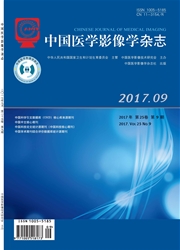

 中文摘要:
中文摘要:
目的利用扩散张量纤维束示踪成像评估多发性硬化(MS)边缘系统纤维通路损害。方法对20例复发缓解型MS患者(MS组)和20名健康志愿者(对照组)进行纤维束示踪成像。追踪扣带束、穹窿、钩束,获得相应纤维条数、FA值、MD值。并进行统计学分析。结果与对照组比较,MS组扣带束、穹窿、钩束FA值均减低(P均〈0.01),MD值均升高(P均〈0.05)。MS组穹窿纤维条数较对照组减少(P〈0.001)。MS组中左侧与右侧钩束纤维条数、对照组中左侧与右侧钩束FA值、纤维条数差异均有统计学意义(P均〈0.05)。MS组扣带束、钩束FA值与EDSS评分呈负相关(r=-0.572、-0.665,P均〈0.05),MD值与EDSS评分呈正相关(r=0.627、0.603,P均〈0.05)。结论纤维束示踪成像对评估MS边缘系统纤维通路损害及监测临床进程有重要应用价值。
 英文摘要:
英文摘要:
Objective To assess the damage of limbic system pathways in relapsing-remitting multiple sclerosis(RRMS)by diffusion tensor imaging(DTI)tractography.Methods DTI tractography was used to acquire fiber numbers,fractional anisotropy(FA),mean diffusivity(MD)of cingulum,fornix,and uncinate fasciculus(UF)in 20 RRMS patients(MS group)and 20 healthy volunteers(control group),and statistical analysis was performed.Results Compared with control group,lower FA value(P〈0.01)and higher MD value(P〈0.05)were found in cingulum,fornix and UF of MS group,and the fiber numbers of fornix decreased in MS group(P0.001).There were significant differences between the left and the right UF in fiber numbers and FA value of control group and the fiber numbers of MS group.Negative correlations were found between FA value of cingulum and UF and EDSS scores in MS group(r=-0.572,-0.665,both P〈0.05),and positive correlations were found between MD value and EDSS scores(r=0.627,0.603,both P〈0.05).ConclusionDTI tractography is valuable in assessing MS associated limbic system damage and in monitoring the clinical progression of the disease.
 同期刊论文项目
同期刊论文项目
 同项目期刊论文
同项目期刊论文
 期刊信息
期刊信息
